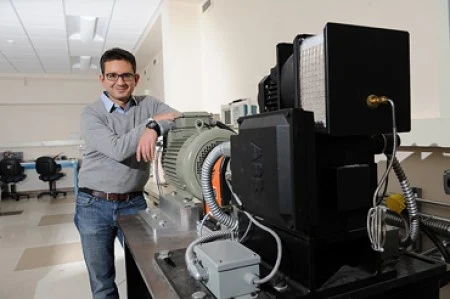Dionysios Aliprantis has a few problems with the current state of electric motors.
First off, the assistant professor of electrical and computer engineering at Iowa State University thinks they’re just too big. Secondly, it’s his contention that they simply don’t work hard enough. Too fat. Too lazy.

To make them leaner and meaner, Aliprantis recently scored a five-year, $400,000 grant from the National Science Foundation’s Faculty Early Career Development Program.
The grants support junior faculty identified as teacher-scholars through outstanding research, excellent education and the integration of education and research.
With the money in hand, Aliprantis and a doctoral student will investigate ways to develop computer modeling technology that will show engineers how to chip away at the surfaces of electric motors to create new designs and shapes that can increase power generation.
“The goal is to get more power out of the same size motor,” he said. “Or, that could mean getting the same power with a smaller motor.”
Aliprantis is not looking for huge increases in power or dramatic reduction in size. “I’m looking for a little bit of increase, maybe 5 percent or 1 percent,” he said. “But multiply that number by the number of hybrid cars, let’s say, and you could get savings in the billions of dollars. The potential here could be huge.”
At the core of Aliprantis’s work is the notion that most electric motors and generators operate in just one direction—in most applications there’s no real need for them to go into reverse. The motors, however, have long been designed to offer equal performance no matter which way they’re rotating.
The engineers are exploring how electric motors can be improved by optimizing performance in a preferred direction of rotation. To do that, they’ve written a computer modeling program that incrementally changes the design of the motors and calculates when the surface shape is just right.
“We are trying to develop a systematic way of getting to the right shape,” Aliprantis said. “This idea is very simple, but motors are still being designed using techniques that are essentially 100 years old.”
It’s the fact that electric motors are all around us—in vehicles, wind turbines, power plants and all kinds of machinery—that makes Aliprantis’s work so intriguing. Through his small, incremental improvements there could be substantial improvements in the development of sustainable energy resources.






